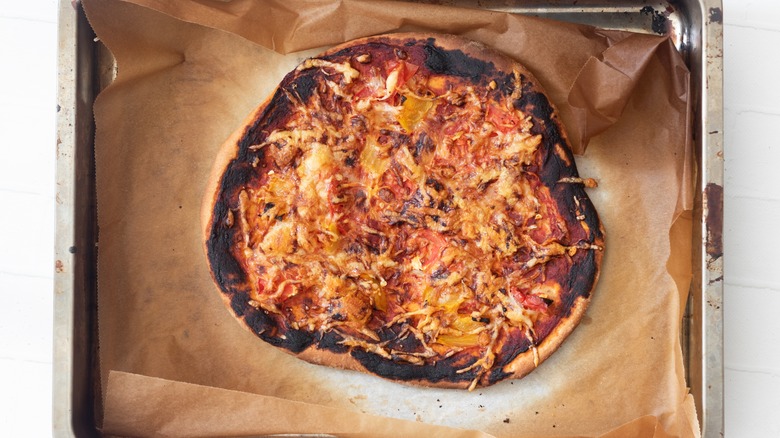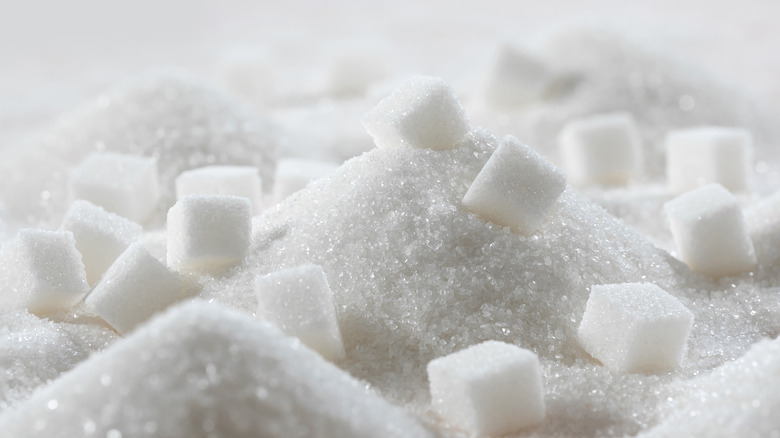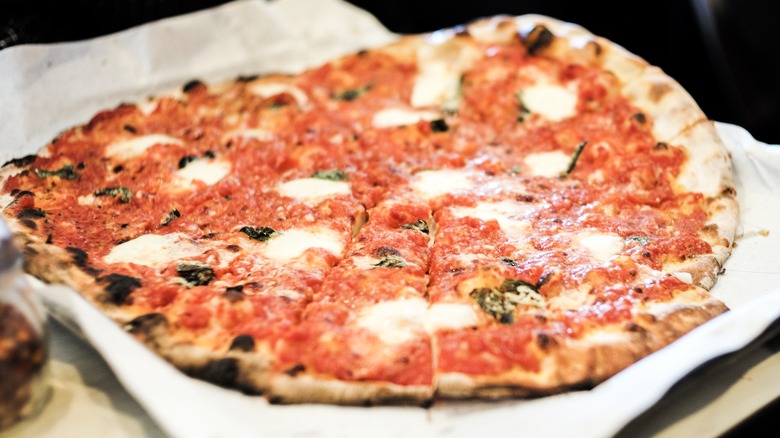Why You Shouldn't Resist Charred Pizza Crust, According To An Expert
"A large cheese pie — not burnt." Those six words have haunted our pizzeria experiences ever since we were young. But it wasn't us saying them. It was actually our dad who first waged a crusade against pizza char.
The order didn't just spur the question, "But what's wrong with burnt pizza?" But it also elicited eye-rolls from wary restaurant staff. It's the same expression we gave customers with the same demand when we worked a brief stint at a pizza joint in college. After all, can pizza really ever be burnt? And why do so many people hate the sooty flavor and charred bottom of a classic New Haven apizza? But with pizza, there's more than meets the crust.
We had an opportunity to chat with food expert Nathan Myhrvold about the true meaning of "burnt" pizza. He's at the epicenter of Modernist Cuisine, a food publishing, research, and everything-in-between outlet. The Cooking Lab has written four books, including "Modernist Pizza," a volume of three books that cover the history and fundamentals of pizza, technique and ingredients, and recipes for home cooks. The team also runs the Modernist Pizza Podcast — which shares tips for pizza in bite-sized, audible form. Here's what he had to say.
Getting the perfect color on your pizza is a matter of science
The first question we must ask is, "How does pizza get its color?" When speaking with Nathan Myhrvold, he noted that a combination of factors contributes to bread getting its color, including its proof time and temperature. He notes that this is the reason why some loaves of bread, like sourdough and Dutch oven bread, develop characteristic blisters on the crust when it absorbs the heat and emits steam. The water on the outside of the crust produces the crackled effect. And when you think about some types of particularly wet pizza dough, like the New Haven-style apizza that comes out characteristically charred, it makes a lot of sense.
Myhrold notes that this effect is amplified in a pizza oven, which runs much hotter than a conventional home oven. These blistering spots also tend to burn faster because of a positive feedback loop. The dark spots attract more infrared heat energy so that they will brown quicker than the blonde crust around them. As Myrhold explains, the same can also be said about your toast at home, which takes comparatively less time to go from brown to burnt than it does from un-toasted to golden. "Well-toasted white bread soaks up more than ten times as much radiant energy from the heating elements as when its surface has darkened, and its reflectivity has fallen," he shares.
The word burnt is often used incorrectly
It's first important to remember that there's a fundamental difference between "burnt" and "charred" pizza. However, many people neglect to use the two separately, instead lumping them into a scornful pile. The bottom of the pizza should be dark brown and firm to the touch rather than too doughy and undercooked to the point where you bite in, and it feels like you're eating Play-Doh. There's nothing wrong with crispy pizza, but there is something wrong with pizza that has been burnt to the point of being unrecognizable. Nathan Myhrvold agrees. He notes that the fine threshold of baking can also alter the flavor of your pie. With properly baked Neapolitan or apizza styles, the contrasting bits of golden brown and char will add to the eating experience, but the pizza that is burnt beyond recognition will not have any sort of pleasant variation. "When you see crusts where the majority of the surface is black and carbonized, the crust will taste acrid with off-flavors," Myhrold explains.
The pizza's exact "perfect" color is also up to the interpretation of the pizzaolo. Many prefer golden-brown and firm crusts, while others desire more leoparding. But if your pizza looks more like a hockey puck than a pie, you should run the other way.
Some ingredients will also cause your dough to burn faster
The chemical composition of your pie might be a reason why it's more prone to charring and burning. One ingredient that will increase the rate at which your pizza crust burns is sugar. The caramelization of sugar starts around 360 F, much lower than your pizza oven's temperature. Sugar is the unexpected sweet touch that you need for more flavorful pizza dough because it will make the savory flavors of your pie pop even more and help the dough puff up even more because the sugars help speed up the yeast eating the starches and releasing the carbon dioxide. Therefore, add it with care to your recipe.
Oil is another ingredient that will make your pizza more prone to burning. Although it serves a vital function in conditioning the dough and makes it easier to stretch, but it can make it burn more prominently when working with a pizza stone or baking steel.
Char is a fundamental element of some pizza styles
There are some styles that welcome the char more than others. The key similarity across these pizza styles is a high oven temperature, such as the case with Neopolitan and New Haven apizza. The latter has a sooty flavor, both because of the high heat the pie is cooked and the coal traditionally used to bake the pizza. Neopolitan pizza is only cooked for about a minute at temperatures upwards of 800 F, which gives the pie its crispy exterior and blisters.
Char is also critical to another type of pizza — that is albeit very different from Neopolitan and New Haven apizza. The Detroit style, which is made in a dark anodized aluminum pan, has a significantly thicker crust and more consistent char than other types of pizza. This crisp crust is thanks to the ability of the pan to hold in heat, as well as the generous coating of oil on the outside of the crust.
Neglecting to bring your dough up to temperature before baking can cause burning, too
The ingredients in your dough aren't just a factor in whether your pizza dough burns. One of the biggest mistakes to avoid when cooking pizza, particularly on a grill, is pulling your dough straight out of the fridge and stretching it right away. The dramatic shift from the cool conditions of your fridge to the hot cooking surface will cause the dough to release water and steam, which sets the charring process into motion. In addition, working with cold dough will cause more bubbles to spring up, which will inevitably burn if they are not popped.
Using warm pizza dough has other benefits. Cold dough is difficult to stretch, leading to misshapen pizza or dough that springs back too much when you try to stretch it. If you're working with store-bought pizza dough, always put it on the counter for a little bit before shaping it.
Eating charred pizza isn't necessairly bad for your health, either
One of the reasons our dad gave us for ordering pizza "not burnt" was because he was under the impression that it caused cancer. This occurs when the amino acid asparagine responds to a decrease in sugar and produces a new compound called acrylamide. Research in animal subjects has suggested that high doses of acrylamide may lead to reproductive issues, liver damage, and cancer — but the results have not been replicated in humans, notes a study in the National Center for Biotechnology Information. There has also been research published, including a study of 368,010 women across 10 European countries, per the World Cancer Research Fund International, that indicates no correlation between eating high-acrylamide foods and cancer risk in humans.
However, some folks in the scientific community recommend limiting your consumption of burnt food, as well as other sources of acrylamide like cigarette smoke and foods like prune juice, coffee, and canned black beans. But should you be concerned about eating a charred piece of pizza occasionally? Probably not.
There are ways to moderate the color of your pizza crust
We're not going to yuck your yum, so if you really like to order your pizza raw-ish, good for you. And if you're looking for ways to get a better color on your pie without going into burnt territory, Nathan Myhrvold has some tips.
He notes that the first thing you can do to reduce the burnt spots is to lower the heat on the floor of the oven or pull the pizza off the surface briefly to allow for airflow and less direct contact with the heat. If your ingredients on the top of the pie burn on contact, it may be a sign that you need to reduce your entire oven's temperature. In between uses, Myrhold notes it's important to sweep the pizza stone off since the excess flour tends to hold in that sooty flavor. But if you're like us and love a good char, leave it in for just a bit longer.
Look for other signs of a bad slice, besides the color of the pie
If you walk into a pizza shop, the color on the bottom of your slice shouldn't be the only sign of a bad slice. The biggest hint at the quality of your pizza might be the other options on the menu. Suppose you're seeing a lot of diner favorites like burgers, sandwiches, or gimmicky pies that are, frankly, quite disturbing. In that case, it might be an indication that your slice shop doesn't take pizza seriously. You'll also want to find a shop that focuses on a single type (or maybe two types) of pies rather than every regional pizza style imaginable.
Another way to determine what your pizza experience might be like would be to look at the pies that other people are ordering. If you notice the entire pie looks like a marshmallow that spent a little too much time in the fire pit, it might be time to find another local joint on Yelp.








